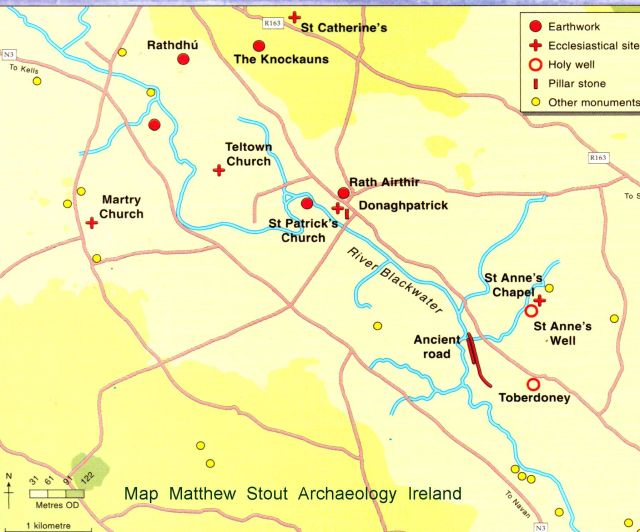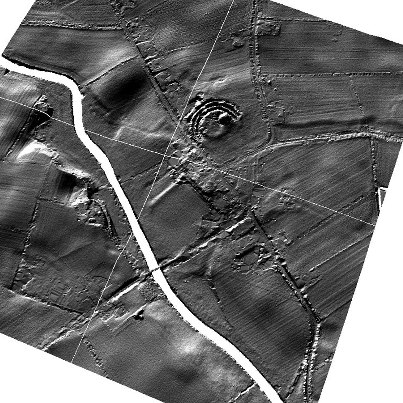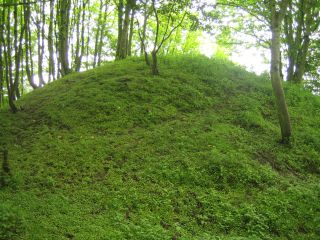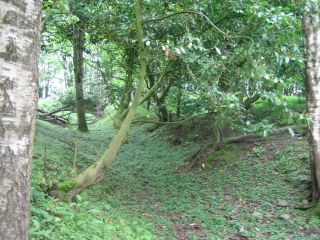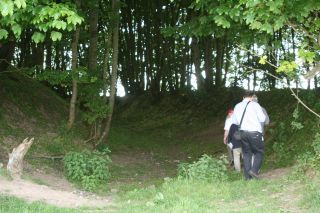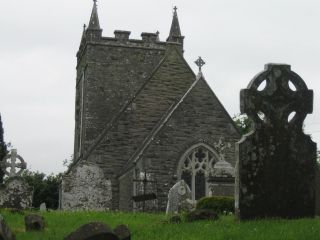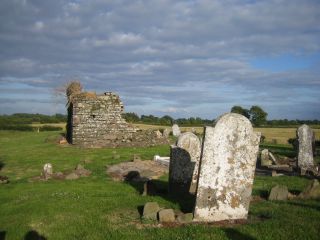See also: Donaghpatrick
Tailteann or Teltown is a very ancient landscape and is one of the most celebrated places in Ireland, almost as old as Tara. It lies on a gentle slope leading down to the R. Blackwater about 5 miles NW of Navan. The Annals of the Four Masters record that the ancient Lughnasa Assembley (one of the quarterly feasts of the old pagan year) was held here on the first Monday in August. Most of these ancient traditions had their origins in funeral games and the fair of Tailteann was the most celebrated for its athletic games and sports.
According to legend, this was instituted by Lug Lamhfhada (Lug of the Long Arm), to commemorate his foster mother Tailtiú, who was buried there, and for whom the place is named.
This is a Lidar image by the Discovery Programme of the landscape around Teltown, and comes from the Cultural Ireland website.
(LiDAR is a remote sensing technology that uses laser scanning to collect height or elevation data.)
The white line is the River Blackwater and Rath Airthir
and its 3 deep ditches or ramparts can be clearly seen.
Remnants of ancient roads, field boundaries and settlements are also visible.
Close to Donaghpatrick Church,on the opposite side of the road is Rath Airthir (the eastern Fort). It is an impressive monument, with its 3 sets of ramparts – a trivallate fort.
(above) Rath Airthir – and views of its ramparts. Photos: © Navan & District Historical Society
Rath Dhú – the Black Fort is one of the most prominent of the Teltown monuments and can be seen on the NW part of the area. It is about 112m in diameter and 6m above the level of the surrounding area.
The Knockauns – (the Crockans – Cnocán a Chrainn -the little hill of the tree). This is a commanding viewing point, as, on a clear day it is possible to see the Wicklow Mountains, Sliabh na Caillaige (Loughcrew Hills), Sliabh Guaire (Cavan Hills) and Sliambh Bréagha (Collon Hills) along the horizon. To the east Tara is visible as is Faughan Hill to the south.
The sweep of flat land below the Knockauns runs down to the R. Blackwater, and this was the ancient sports theatre of the Aonach. Aonach Tailteann was held for 15 days starting on the first Monday of August. Here horse races and chariot races were run, and great feats of strength like boxing, wrestling and other manly sports took place. The evenings were quieter, devoted to singing and story telling. (See Cuan Ó Lothchain’s poem for a flavour of the atmosphere of the Aonach around 1000 AD when the games were revived.)
Below are some references to the Fair at Teltown from the Annals of the Four Masters, from the Cultural Heritage Ireland website:
539 AD
The decapitation of Abacuc at the fair of Tailltin, through the miracles of God and Ciaran; that is, a false oath he took upon the hand of Ciaran, so that a gangrene took him in his neck (i.e. St. Ciaran put his hand upon his neck), so that it cut off his head.
715
The fair of Tailltin was celebrated by Fearghal, son of Maelduin; and Fogartach Ua Cearrnaigh disturbed the fair, for he killed Maelrubha, and the son of Dubhsleibhe.
806
The prevention of the celebration of the fair of Tailtin, so that neither horse nor chariot was run, by Aedh, son of Niall; i.e. the family of Tamhlacht prevented it, in consequence of the violation of Termon of Tamhlacht Maelruain. Aedh Oirdnidhe afterwards gave their full demand to the family of Tamhlacht, together with many gifts.
825
The destruction of the fair of Tailltin, against the Gaileanga, by Conchobhar, son of Donnchadh, on which occasion many were slain.
887
The fair of Tailltin was celebrated by Flann, son of Maelsechnaill.
894
and the renewal of the fair of Tailltin by Diarmaid, son of Cearbhall; and both were celebrated by them.
915
The fair of Tailltin was renewed by Niall (Glundubh, the High King).
925
The fair of Tailltin was prevented by Muircheartach, son of Niall, against Donnchadh Ua Maeleachlainn, in consequence of a challenge of battle which was between them; but God separated them, without slaughter or bloodshed on either side.
Tradition has it that marriages were celebrated here in pagan times. A young man and woman joined hands in a hole in a wall at this location (not being visible to each other) and thereafter lived together for a year and a day. After this time, they returned to the site, and if they were not satisfied with each other, they separated amicably, and could walk away to try their luck at the wall the following year.
Christian Times: Christianity came to Ireland in the middle of the 5th century. Legend has it that St. Patrick visited Tailteann at the time of the royal games, and was treated with hostility by Coirpre (brother of Laoghaire the king then residing at Tara) who presided over them. Coirpre sought to kill Patrick and had his servants flogged into the R. Blackwater, then called Sele, when the Saint called him “an enemy of God”. Patrick forcasted that Coirpre’s descendants would never become kings. He also cursed the Sele, which afterwards, and ever since, its waters have taken on a dark hue, and its name was therefore changed to Abhainn Dubh or Blackwater.
Four Christian churches are found within this landscape all originally built within circular enclosures typical of early Christian times. These enclosures have largely disappeared. The churches are Donaghpatrick, the medieval church at Teltown, and that of St. Catherine which lies to the northern extremity of this area. The fourth church is now known as Martry. The Annals imply that it was associated with the great Columban foundation at Kells.
Photos©Navan & District Historical Society
(above) Donaghpatrick Church and the remains of Teltown Medieval Church and graveyard.
Aonach Tailteann Revived
An early attempt to revive the ancient Games (spearheaded by Michael Cusack and Michael Davitt) in 1884, came to nothing because of financial constraints. A further attempt in 1922 had to be abandoned because of the outbreak of the Civil Was in 1922. (although the Australian delegation had already left Australia!)
But Croke Park was the venue for the Aonach Tailrteann in 1924, 1928 and 1932 (which was overshadowed by the Eucharistic Congress held the same year). The games did not take place after this because of the depressed state of the Irish economy at this time.
~~~~~
Sources for above:
Teltown – An Ancient Assembly Site in County Meath.
Archaeology Ireland Heritage Guide no 3
Cultural Heritage Ireland website: www.culturalheritageireland.ie
Aonach Tailteann – from a Pagan Celebration to its 20th Century Revival
Harry McGarry unpublished thesis presented to Dept. of Modern History NUI Maynooth 1987
*******
Parliamentary Gazzateer of Ireland, 1845
The Lewis Topographical Directory was first published in 1837 in two volumes, with an accompanying atlas. The first edition is available online. A second edition was published in 1842.
Lewis relied on the information provided by local contributors and on the earlier works published such as Coote’s Statistical Survey (1801), Taylor and Skinner’s Maps of the Road of Ireland (1777), Pigot’s Trade Directory (1824) and other sources. He also used the various parliamentary reports and in particular the census of 1831 and the education returns of the 1820s and early 1830s. Local contributors were given the proof sheets for final comment and revision. The names of places are those in use prior to the publication of the Ordnance Survey Atlas in 1838. Distances are in Irish miles (the statute mile is 0.62 of an Irish mile).
Teltown, a parish in co. Meath, barony of Upper Kells, union of Kells, diocese of Meath, 2 miles north from Ballybeg Crossing station on the Great Northern railway and 3 3/4 south east from Kells, on the river Blackwater: it contains 5 townlands and the village of Oristown. Hurdlestown is the seat of William P. Radcliffe esq. J.P. The area comprises 4,267 acres; the population in 1891 was 584.
Constabulary Station, William Clare, sergeant in charge.
Catholic Church, Oristown, Rev. George A. Taaffe P.P.; Rev. Charles Cremior c.c
Private Residents:
Crinion, Rev. Francis, c.c. Oristown
Ffrench, Capt
Caulfield, J.P
Radcliffe, William P. j.p. Hurdlestown
Taaffe, Rev. George A. P.P. Oristown
Commercial:
M’Grath, John, cattle dlr. Kilmainham
Stopford, James B., publican & farmer, Oristown
Farmers:
Gogarty, Christopher, Cordrum
Hopkins, Matthew, Kilmainham
Lee, Nicholas, Oristown
M’Grath, John, Kilmainham
Martin, James, Oristown
Mullan, Michael, Oristown
Murtagh, Matthew, Oristown
Stopford, James B. Oristown
Photographs ©Navan & District Historical Society

